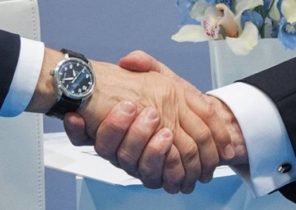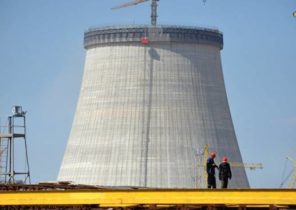Forecast of Russian economy for 2020
The majority believes that under the impact of a pandemic of a new type of coronavirus in 2020 the growth of the Russian economy will be negative, as in the major countries of the world.
The latest information submitted to the Agency TASS. It conducted a survey among key Russian rating agencies and analytical departments of banks and published the average consensus forecast, so consider it.
Forecast of different institutions regarding the growth of GDP in 2020 are shown in the chart below (given in the original article — ed. ed.). The majority believes that the rate will be minus 4 — 5%, and only “alpha Bank” assumed a relatively slight decline of minus 1%.
The average is a minus of 4.1%. That is, at the moment this is the consensus forecast for Russia.
According to the forecasts of “Alfa-Bank”, whose assumption was most soft, in between April to June, the indicator will drop to minus 6%, but under condition of return of economic activities to the normal level since July total annual value will be approximately minus 1%.
By the way, was also presented the consensus forecast relating to other indices: inflation in 2020 will be 3.9%, the ruble to the end of the year — 70 rubles per dollar.
Moreover, it expresses the idea that negative growth will continue until the end of 2020, but in 2021 it will rise in the plus area. With regard to the consensus forecast for 2021, the economic growth will be a plus of 2.7% inflation — 3.7% rate by the end of 2021 — 70 rubles to the dollar that will not be different from 2020.
By the way, if to analyze the information about the Russian economy, the impression that the government will have to take anti-crisis measures in two different directions.
Speaking in military terms, Russia will have to fight on two fronts: the first is the problem of small and medium business, employment and income, the second is the impact of the collapse in oil prices on the financial environment.
Of course, there are many other problems, but in General they can be grouped into these two main. Then try to analyze them.
The most affected areas
The government has identified economic areas that most affected by the pandemic of the novel coronavirus. Now it is attempting to support these areas. The list submitted by the authorities on 18 April, the following:
— Aviation
— Cultural and entertainment business
— Sports business
Tourism
— Hospitality
— Catering
School of intensive training and qualification
— Conferences and events
— Personal services (appliance repair, dry cleaning, hairdressing)
— Dentistry
— Retail trade (cars, appliances, electronics and communication, clothing)
In all countries, the epidemic affects mostly the same areas that are associated with the movement and contacts. In addition, with regard to the retail business, the trade in basic foodstuffs suffered less than others, but for consumer durables and clothing, which are not necessities, was dealt a heavy blow.
The aforementioned areas marked by the Russian government, affect these areas. Until the lifting of restrictions on overseas travel and access to the street, demand in these areas will not be restored. To exit from the crisis in this business will have to survive only due to the support of the government.
Conversely, due to the coronavirus crisis has its chance new services using the Internet, avoiding movements and contacts. According to some, Russia is also rapidly evolving areas such as service and products, online training, trade and medicine, remote conference using Zoom and Teams, cybersecurity and Internet banking.
So, in line with the government’s list of victims because of the new coronavirus companies, composed of the representatives of big business, for example, carriers, dealers, cars and household appliances, but a considerable share is also small and medium businesses, and individual entrepreneurs.
In Russia, the service sector, which provides small and medium businesses, has a powerful influence and ability to pull the whole economy. However, it is important from the point of view of providing jobs.
Among the working population of Russia, amounting to 72 million people, the number of employees of large companies and civil servants has 32 million people. The remaining 40 million work in small businesses or as entrepreneurs.
The pandemic is a direct attack on small businesses and entrepreneurs that have threatened jobs and income in Russia.
In fact, during previous economic crises, the situation has not affected hiring. In addition, it is worth noting that Russia has not accumulated any know-how to support small and medium-sized businesses. The Federal government declares their support, however, detailed measures are almost not taken.
Oil and Finance
The pillars of the Russian economy is the oil and gas exports. Russia is a country that covers about half of Federal budget revenues at the expense of oil and gas. In 2020, the global demand for energy decreased under the influence of the novel coronavirus. The situation was complicated by the lack of coordination between OPEC+ to limit production, and oil prices collapsed. Naturally, this complicates the situation in Russia deteriorates and her financial situation.
Some experts, poorly versed in Russian reality, were inclined to declare that due to the collapse in oil prices, Russia was on the verge of collapse. However, actually the Russian Finance there is a certain buffer, so in the near future nothing will happen.
In Russia there are the following system: establishes a specific price level for oil, and if its actual value exceeds this level, the resulting extra profits from oil and gas is automatically diverted to the Fund of national welfare (this is called the budget rules).
Conversely, if the real price of energy is below a preset level, the shortage is covered from the Fund of national welfare, in order to avoid revenue shortfalls.
According to the Russian expert on budget issues to cover holes in 2020 and 2021, resulting from the reduced revenues from oil and gas, will require six trillion rubles, which is 2.8% of GDP.
At this point in the Fund of national welfare has 8% of GDP. Consequently, even if oil prices will remain low for two years, Russia will be able to cope with this through the use of the Fund, the expert said.
However, he also emphasizes that a distinctive feature of coronavirus pandemic is the reduction of income and in other fields besides energy. The calculations showed that in 2020 and 2021 in the non-energy sector will occur following the reduction of: Federal budget — 0,8 — 1% of GDP; social protection Fund — 0,6%; regional budgets of 1.8 — 1.9%. If you add up all this, it is obvious that there is a shortage of state revenues in excess of 3% of GDP.
Commenting on this, the expert notes: “Theoretically, the decrease of revenues offset by increased issuance of government bonds. However, amid the chaos of the ability of banks to purchase government bonds is limited. The fact is that due to declining revenues, the Russian investors will reduce savings, and the banks will increase bad debts. When signs of the crisis, foreign investors withdraw money from emerging markets countries. Consequently, the Central Bank should buy government bonds and to provide the government finances by running a printing press. It is practiced in other countries because there are more pluses than minuses”.
The bottom line is that a pandemic of the novel coronavirus and the collapse in oil prices means that it is impossible for Russia to adhere to exemplary financial and fiscal policy. But this does not imply that in near future there will be financial collapse.







